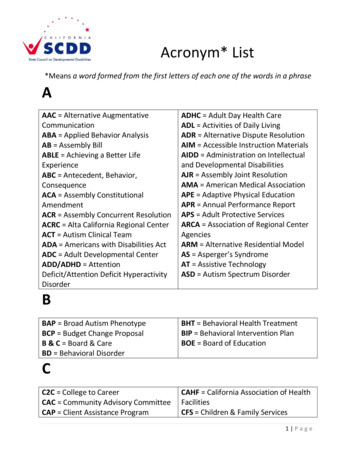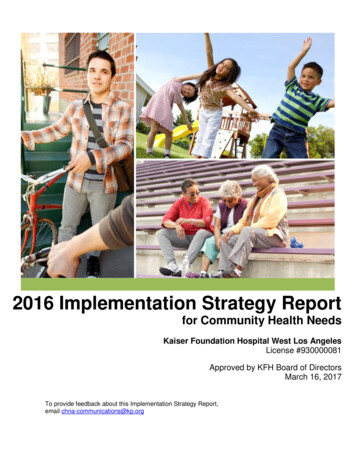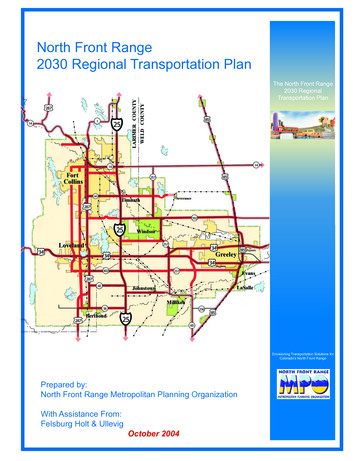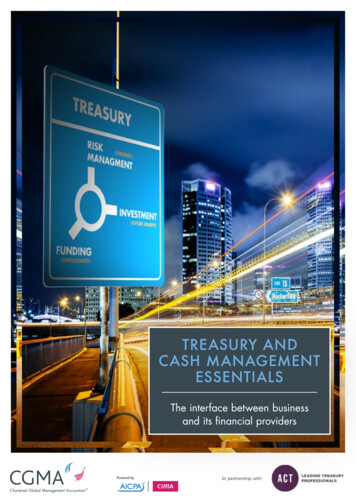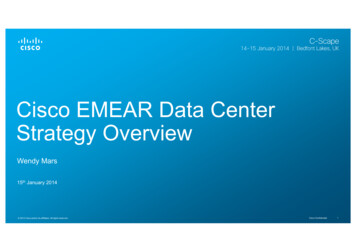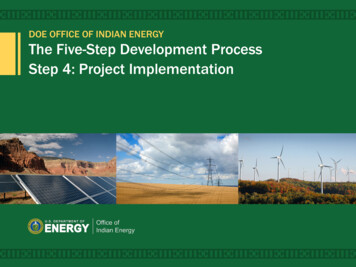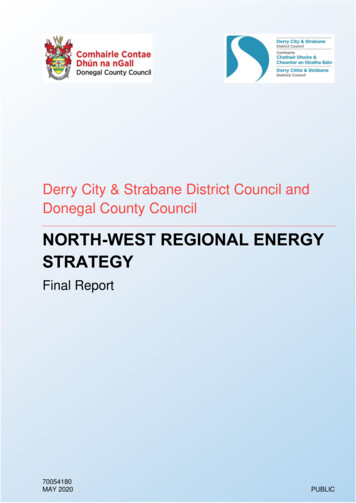
Transcription
Derry City & Strabane District Council andDonegal County CouncilNORTH-WEST REGIONAL ENERGYSTRATEGYFinal Report70054180MAY 2020PUBLIC
Derry City & Strabane District Council and DonegalCounty CouncilNORTH-WEST REGIONAL ENERGYSTRATEGYFinal ReportTYPE OF DOCUMENT (VERSION) PUBLICPROJECT NO. 70054180OUR REF. NO. 70054180DATE: MAY 2020PUBLIC
QUALITY CONTROLIssue/revisionFirst issueSecond IssueSecond IssueRemarks-Updated to reflectclient feedbackUpdated &RevisedDate16/07/201928/01/202006/05/2020Prepared byAnthonyDonoghueAnthonyDonoghueCiaran McGrathEddie HessellEddie HessellChecked byAnthonyDonoghueAnthonyDonoghueLeo StrawbridgeAuthorised byAnna FergusonAnna FergusonLeo StrawbridgeProject number700541807005418070054180NORTH-WEST REGIONAL ENERGY STRATEGYProject No.: 70054180 Our Ref No.: 70054180Derry City & Strabane District Council and Donegal County CouncilPUBLICMay 2020
CONTENTSEXECUTIVE SUMMARY1INTRODUCTION11.1A LOW CARBON FUTURE ENABLED LOCALLY11.2LOCATION OF REGION21.3VISION FOR DERRY CITY & STRABANE (DCS) & COUNTY DONEGAL (CD)21.4ENERGY POLICIES32EXISTING ENERGY SYSTEM92.1REGIONAL GENERATION MIX92.2REGIONAL ENERGY CONSUMPTION AND DEMAND102.3OTHER ITEMS163EXISTING UTILITY SECTOR193.1ELECTRICTY NETWORKS193.2HEAT NETWORKS213.3WATER NETWORKS244REGIONAL ENERGY CARBON ASSESSMENT264.1INTRODUCTION264.2ASSESSMENT TOOL METHODOLOGIES275LOCAL CHALLENGES AND OPPORTUNITIES325.1LOCAL CHALLENGES325.2OPPORTUNITIES466REGIONAL ENERGY STRATEGY & ROADMAP606.1SMART ENERGY MANAGEMENT62NORTH-WEST REGIONAL ENERGY STRATEGYProject No.: 70054180 Our Ref No.: 70054180Derry City & Strabane District Council and Donegal County CouncilPUBLICMay 2020
6.2RENEWABLE GENERATION AND ENERGY STORAGE656.3LOW CARBON TRANSPORT676.4LOW CARBON HEATING696.5ENERGY EFFICIENCY717ROLE OF INNOVATION737.1NATIONAL INNOVATION PROJECTS737.2COUNCIL INNOVATION PROJECTS737.3INNOVATION TOPICS778CONCLUSIONS809RECOMMENDATIONS & NEXT STEPS829.1THE NORTH-WEST SMART ENERGY SYSTEM (NWSES) STUDY829.2EXTERNAL BODY86REFERENCES88NORTH-WEST REGIONAL ENERGY STRATEGYProject No.: 70054180 Our Ref No.: 70054180Derry City & Strabane District Council and Donegal County CouncilPUBLICMay 2020
FIGURESFigure 1-1 - Location of Donegal County and Derry City & Strabane District2Figure 1-2 - EU Greenhouse Emissions Reduction Targets3Figure 1-3 - UK Carbon Budgets and 2050 Target4Figure 1-4 - UK Reduction in Greenhouse Emissions Comparison (Actual vs Carbon BudgetValues)5Figure 1-5 - Republic of Ireland Greenhouse Emissions Reduction Targets6Figure 1-6 - Republic of Ireland Reduction in Greenhouse Emissions (Actual vs Target)6Figure 2-1 - Examples of Generators within the North-West region and their Locations Error!Bookmark not defined.Figure 2-2 - Proportion of Electricity Generation in the Republic of Ireland and NorthernIreland10Figure 2-3 - Derry City & Strabane Energy Consumption by Fuel Type and Sector11Figure 2-4 - Proportion of Energy Use within Domestic Premise12Figure 2-5 - Proportion of Main Space Heating Fuel for the North-West Region12Figure 2-6 - Proportion of Transport Used for Making Journeys13Figure 2-7 - Proportion of Transport Energy Consumption for Derry City & Strabane14Figure 2-8 - Percentage of Total Employment in Each Broad Sector in Donegal County andState14Figure 2-9 - Percentage of VAT and/or PAYE Registered Businesses Operating in DerryCity and Strabane and Northern Ireland by Broad Industry Group15Figure 2-10 - Number of Employee Jobs for DCS by Sector15Figure 2-11 - Annual CO2 Emission Estimates for DCS between 2005 and 201617Figure 3-1 - Electricty Network Heat Map for Northern Ireland20Figure 3-2 - Irish gas transmission network22Figure 3-3 - Map of New Gas Network Connections22Figure 2-1 – North-West Region Carbon Baseline28Figure 2-2 – Total Segmented Breakdown28Figure 5-1 - Wind Energy Development Acceptability in Donegal Countynot defined.Figure 5-2 - Population Dispersion within Donegal CountyNORTH-WEST REGIONAL ENERGY STRATEGYProject No.: 70054180 Our Ref No.: 70054180Derry City & Strabane District Council and Donegal County CouncilError! BookmarkError! Bookmark not defined.PUBLICMay 2020
Figure 5-3 - Percentage of Transport Use for County Donegaldefined.Error! Bookmark notFigure 5-4 - Percentage of Transport Use for Derry City and Strabane District for2013Error! Bookmark not defined.Figure 5-5 - Map and Road Network of the RegionError! Bookmark not defined.Figure 5-6 - Relative Deprivation of Donegal CountyError! Bookmark not defined.Figure 5-7 - Location of Most Deprived Areas in DCSError! Bookmark not defined.Figure 5-8 - Domestic Building Energy Rating (BER) Proportions for Donegal County andROIError! Bookmark not defined.Figure 5-9 - Average Domestic Energy Prices in /kWh for EU Countries at the First Half of2018Error! Bookmark not defined.Figure 5-10 - Map of DSO Released Live Auctions48Figure 5-11 - Map Highlighting the Proportion of Heat Loads within NI and DCS51Figure 6-1 - Details on target energy sectors for the pathway to decarbonisation60Figure 9-1 - Flowchart of Smart Energy System workstreams83NORTH-WEST REGIONAL ENERGY STRATEGYProject No.: 70054180 Our Ref No.: 70054180Derry City & Strabane District Council and Donegal County CouncilPUBLICMay 2020
ABBREVIATIONSAbbreviationCDDCSDCDefinitionCounty DonegalDerry City and Strabane District CouncilDCSDerry City and StrabaneDCCDonegal County CouncilEVElectric VehiclesPVPhotovoltaicsDSODistribution System OperatorDNODistribution Network OperatorDGDistributed GenerationLCTLow Carbon TechnologiesLCELow Carbon EconomyCHPCombined Heat and PowerDHDistrict HeatingHPHeat PumpNIENorthern Ireland Electricity (Networks)ESBElectricity Supply Board (Networks)ROIRepublic of IrelandNINorthern IrelandUKUnited KingdomAIArtificial IntelligenceIPCCIntergovernmental Panel on Climate ChangeNORTH-WEST REGIONAL ENERGY STRATEGYProject No.: 70054180 Our Ref No.: 70054180Derry City & Strabane District Council and Donegal County CouncilPUBLICMay 2020
EXECUTIVE SUMMARYThis report contains the North-West Regional Energy Strategy for Derry City & Strabane District Council(DCSDC) and Donegal County Council (DCC).All information is correct at the time of writing and any assumptions or predictions made have been done sowith reference to credible sources.Derry City & Strabane District Council (DCSDC) and Donegal County Council (DCC) both recognise the needto transition towards a smart, low carbon economy which can deliver sustainable prosperity for individuals,communities, businesses and the local environment within the North-West Region. To fulfil this goal, bothcouncils have collaborated, with the support of WSP, to define a clear and structured North-West RegionalEnergy Strategy as one combined region.This strategy supports the increasing global consensus arising from the IPCC’s 2018 report that identifies theurgent need to accelerate decarbonisation objectives and has been aligned with “Net Zero” emissions targets.Importantly, the UK Parliamentary Climate Change Committee (CCC) in its recent report recommends thatlocal authorities must be proactive and pursue strategies that are designed to eliminate carbon emissionswithin their regions given the specific nature of their individual energy system.This report therefore aims to provide a strategic rationale and direction for the North West region to achieveits vision for a Net Zero emissions Energy sector by 2045. The Roadmap contained herein proposes astrategy that can deliver real reductions in annual carbon emissions, whilst encouraging the growth of a lowcarbon economy, improving the security of supply and minimising the environmental impact of all futureactivities.This strategy recommends a Whole Energy System approach and provides a holistic view on theconsumption and management of energy throughout the region. A wide variety of local measures have beenrecommended as potential opportunities to encourage the adoption of renewable Low Carbon Technologies(LCTs) both for the consumption and generation of energy within the North-West Region.It is important that the North-West Region has a very clear plan on how it should become carbon neutralgiven the specific characteristics and requirements of the area. This plan should coordinate all energy vectorstogether to optimise energy consumption across the North-West Region and minimise both Greenhouse Gas(GHG) emissions and customer bills whilst minimising cost and maximising opportunity for all who live andwork within the area.Through the acceleration of this transition, the North-West Region is presented with a huge opportunity inbecoming a proactive “prosumer” in the energy market and contributing towards future balancing marketsboth with the electricity transmission and distribution networks, as well as the gas networks. The area intendsto build a template to demonstrate how local authorities can intelligently decarbonise to meet bindingemission targets whilst encouraging sustainable economic growth.NORTH-WEST REGIONAL ENERGY STRATEGYProject No.: 70054180 Our Ref No.: 70054180Derry City & Strabane District Council and Donegal County CouncilPUBLICMay 2020
Both Councils have a history of driving energy conservation throughout their organisations, and through theongoing delivery of this strategy, wish to remain a driving force for innovation in the region. They will bringtogether the strands necessary within their own organisations, working with the private sector stakeholdersand academia to deliver the objectives as set out within the report.It is recommended that the North West Regional Energy Hub project body is established, closelyfollowing the excellent examples set out in Section 7 of the report in both Ireland and England.Contact Name: Leo StrawbridgeContact details: Leo.Strawbridge@derrystrabane.comNORTH-WEST REGIONAL ENERGY STRATEGYProject No.: 70054180 Our Ref No.: 70054180Derry City & Strabane District Council and Donegal County CouncilPUBLICMay 2020
1INTRODUCTIONPUBLIC
1INTRODUCTIONThis report aims to evaluate the energy opportunities and local measures that are available to both councilswithin the North-West Region to encourage the growth of a sustainable low carbon economy. To do this, aclear strategy and roadmap has been developed which shows the local measures that can be taken todecarbonise the Region by 2045.1.1A LOW CARBON FUTURE ENABLED LOCALLYThe evidence in support of climate change is well documented; 17 of the 18 warmest years on record haveoccurred within the 21st century and the last 3 decades have each been warmer than the last [1]. TheIntergovernmental Panel on Climate Change (IPCC) have concluded that the scientific evidence for humaninfluence on a warming climate is indisputable [2].Action is required to secure a sustainable future for generations to come and local authorities have animportant and critical role to play. Climate change is a global challenge but beneath this, local regions musthave clear strategies in place to ensure the causes of global warming are addressed.The UK Climate Change Committee (CCC) has recommended in their recent report that the Governmentshould “set and vigorously pursue” more ambitious targets to reduce Greenhouse Gas (GHG) emissions to'net-zero' by 2050 [3]. Importantly the CCC warned that achieving such objectives required that “clear, stableand well-designed policies to reduce emissions further are introduced across the economy without delay”.The Irish Government published their own Climate Action plan on 18th June ensuring Ireland achieved a NetZero emissions target by 2050 [4]. This is in addition to supporting the wider EU Government’s recently statedintentions for a 2050 net zero target that would be binding for all member states.This need to address climate change has given rise to a Low Carbon Economy which is already having apositive effect on the wider economy. In 2016, the industry turnover in Northern Ireland reached almost 1billion, supporting 5000 jobs and 4000 businesses [5]. As well as addressing climate change and creating alow carbon future, energy security and cost can also be addressed. Implementing innovative solutionsincluding LCTs can not only prevent this energy price increasing for consumers but can help decrease itsoverall cost.As the global energy transition is founded upon exploiting distributed sustainable energy sources, it isindividual regions that are best placed to drive emission reductions, based upon their detailed understandingof the local demands, challenges and opportunities. A central pillar of the UK’s Industrial strategy is totransition the energy supply value chain from reliance upon centralised fossil fuel generation to one built upondistributed energy sources managed within local Whole Energy Systems.Derry City & Strabane District Council (DCSDC) and Donegal County Council (DCC) have therefore joinedforces to build a co-ordinated Regional Energy Strategy for the North-West Region. Their approach is to takea leading role and facilitate local and regional stakeholders towards a decentralised smart energy systemdesigned to meet the regional energy needs and facilitate achieving a Regional goal of net zero emissionsby 2045.This report takes a strategic view of all sources of energy consumed across the North-West Region. Thisincludes energy generated for power, transport, heating, waste and water management, that are supplied byvarious sources such as electricity, gas, fuel oil, and petrol /diesel etc. Each source of energy consumedNORTH-WEST REGIONAL ENERGY STRATEGYProject No.: 70054180 Our Ref No.: 70054180Derry City & Strabane District Council and Donegal County CouncilPUBLICMay 2020Page 1 of 96
within the region contributes towards annual carbon emissions and it is therefore imperative to take a WholeEnergy System view which incorporates all sources of energy production and consumption.1.2LOCATION OF REGIONThe two areas that are referred to in this report are County Donegal (CD), located in the northern part of theRepublic of Ireland (ROI), and Derry City and Strabane (DCS) district, located in the north-western part ofNorthern Ireland (NI).Figure 1-1 shows a map highlighting both areas [6]. Throughout this report, the term ‘North-West Region’ isused to describe both regions. Unless otherwise specified, this report considers a single overall strategy thatapplies to both regions.Figure 1-1 - Location of Donegal County and Derry City & Strabane District1.3VISION FOR DERRY CITY & STRABANE (DCS) & COUNTY DONEGAL (CD)This report intends to encourage a holistic view of the energy system within the North-West Region bycoordinating multiple energy vectors together in order to optimise energy consumption across the area byboth minimising greenhouse gas emissions and reducing customer bills. The North-West Region will therebyaim to become a leader in achieving national and international climate change targets and set long term goalsto become a “Net Zero Carbon Region” by 2045.In doing so it is important that the North-West Region maintains a sustainable, secure and affordable energysystem for all citizens’ whilst also maximising the area’s opportunities for economic growth. This Reporttherefore makes recommendations for sustainable economic growth across the North-West Region whilstminimising the environmental impact to realise the low carbon society which is so critical for our future.NORTH-WEST REGIONAL ENERGY STRATEGYProject No.: 70054180 Our Ref No.: 70054180Derry City & Strabane District Council and Donegal County CouncilPUBLICMay 2020Page 2 of 96
1.4ENERGY POLICIES1.4.1EUROPEAN UNIONThe EU has implemented various policies and strategies to ensure that member states can provide secure,affordable and sustainable energy to their citizens as described below. Several reduction targets have beenset for three different time periods as highlighted in Figure 1-2. By 2020, the EU aims to reduce its greenhouse gas emissions by at least 20% of 1990 levels, increasethe share of renewable energy to at least 20% of consumption, and achieve energy savings of 20% ormore [7]. Furthermore, all EU countries must also achieve a 10% share of renewable energy in theirtransport sector. By 2030, the EU aims to reduce its greenhouse gas emissions by at least 40% of 1990 levels, increasethe share of renewable energy to at 27% consumption, improve energy efficiency by at least 26%(indicative target, to be reviewed by 2020), and support the completion of the internal energy marketby achieving an interconnection target of 15% [8]. By 2050, the EU aims to reduce its greenhouse gas emission by 80-95% of 1990 levels, forming thelong-term goal of significant emission reduction [9].Following the IPCC report published in 2018 [10], the EU are presently considering a redefinition of theiremissions reduction targets based upon achieving net zero by 2050.Figure 1-2 - EU Greenhouse Emissions Reduction TargetsThe EU plans to meet these targets by accelerating investment into efficient buildings, products and transport,building a pan-European energy market through the construction of network infrastructure, protectingconsumer rights in the energy sector and pursuing good relations with the EU’s external suppliers of energyand energy transit countries.NORTH-WEST REGIONAL ENERGY STRATEGYProject No.: 70054180 Our Ref No.: 70054180Derry City & Strabane District Council and Donegal County CouncilPUBLICMay 2020Page 3 of 96
1.4.2UK ENERGY STRATEGYIn 2017, The Clean Growth Strategy [11] was published to describe how the UK will meet its ambitious carbonreduction targets as set out in the Climate Change Act of 2008 [12]. The UK has a target to reduce its annualemissions by 80% of 1990 levels by 2050 as shown in Figure 1-3.However, in May 2019 the CCC published its “Net Zero” report which recommends that the UK should aimto reduce GHG emissions to 'net-zero' by 2050, ending the UK's contribution to global warming within 30years [3].Figure 1-3 - UK Carbon Budgets and 2050 TargetThe key policies and proposals within the UK Government’s Clean Growth Strategy provides a view on howthese targets can be met and focusses on the following areas: Accelerating clean growth Improving business and industry efficiency Improving our homes Accelerating the shift to low carbon transport Delivering clean, smart, flexible power Enhancing the benefits and value of our natural resources Leading the public sector Government leadership in driving clean growthFigure 1-4 shows the actual percentage reductions of greenhouse emissions compared to the carbon budgettargets [13]. UK emissions were 43% below 1990 levels in 2017. The first carbon budget (2008-12) has beenNORTH-WEST REGIONAL ENERGY STRATEGYProject No.: 70054180 Our Ref No.: 70054180Derry City & Strabane District Council and Donegal County CouncilPUBLICMay 2020Page 4 of 96
met and the UK is currently on track to outperform the second (2013-17) and third (2018-22) carbon budgets,but is not on track to meet the fourth, which covers the period 2023-27.Meeting future carbon budgets and the UK’s present 2050 target to reduce emissions by at least 80% of 1990levels will require reducing domestic emissions by at least 3% per year. This will require existing progress tobe supplemented by more challenging measures [3]. This could however require a further redefinition ofbudgets if the UK Government legislates for a “Net Zero” target by 2050.In Northern Ireland (NI), total energy demand is expected to remain relatively flat within the range of a 2%reduction by 2030 to a 15% increase in the high scenario. Renewable energy sources currently make up 30%of this demand which is expected to grow through developments in both onshore wind and solar photovoltaicgeneration [14]. Gas (55%) and Coal (15%) currently make up the majority of the remaining 70%.Figure 1-4 - UK Reduction in Greenhouse Emissions Comparison (Actual vs Carbon Budget Values)1.4.3REPUBLIC OF IRELAND ENERGY STRATEGYThe Republic of Ireland (ROI) has also set its own strategy to tackle energy and greenhouse emissions. In2015, the Department of Communications, Energy & Natural Resources released ‘Ireland’s Transition to aLow Carbon Energy Future’ [15] which set out Irelands energy strategy from 2015 to 2030.In June, the Department of Communications, Climate Action & Environment released the ‘Climate ActionPlan 2019’, which re-evaluated the emissions targets set previously [4]. The government has now stated thatit “will support the ambition emerging within the European Union to achieve a net zero target by 2050” andhave “sought a pathway to 2030 which would be consistent with a net zero target by 2050”. Some of the keymeasures to help create a framework and support change include: Consistent development of a Green Procurement Strategy Targets of 50% Energy Efficiency and 30% greenhouse gas emissions reduction A trajectory for the price of carbon to create incentives which help avoid locking in carbon intensivetechnologies The realisation of the principle underpinning Project Ireland 2040 for compact, connected, andsustainable development; andNORTH-WEST REGIONAL ENERGY STRATEGYProject No.: 70054180 Our Ref No.: 70054180Derry City & Strabane District Council and Donegal County CouncilPUBLICMay 2020Page 5 of 96
Competitive funding rounds to promote research and innovation to meet the climate challengeFigure 1-5 shows Ireland’s emission targets.Figure 1-5 - Republic of Ireland Greenhouse Emissions Reduction TargetsFigure 1-6 shows Irelands actual greenhouse emissions compared with the targets set-out [16]. As of 2014,Ireland has managed to meet 8.6% for the total renewable energy sources making up final energyconsumption and was almost halfway (at 8-9%) of achieving its goal of a 20% improvement in energyefficiency.Figure 1-6 - Republic of Ireland Reduction in Greenhouse Emissions (Actual vs Target)NORTH-WEST REGIONAL ENERGY STRATEGYProject No.: 70054180 Our Ref No.: 70054180Derry City & Strabane District Council and Donegal County CouncilPUBLICMay 2020Page 6 of 96
Accelerated development is needed in the country if they plan to meet published targets particularly if energydemand continues to increase. It is estimated that electricity demand in Ireland could grow by 57% in thenext 10 years [17]. The Sustainable Energy Authority of Ireland proposed a number of areas to focus on.These include: Upgrade homes and businesses to make them more energy efficient (Grant schemes have beenapplied to more than 25,000 homes/businesses in 2014). Increase the total wind generation capacity Increase supply of biofuels to be blended with fossil fuels for transport Policy incentives to accelerate adoption of electric vehicles (private and commercial) Encouraging the installation of renewable heat options, such as biomass boilers, solar thermaland biomass CHP system, in homes and businesses.NORTH-WEST REGIONAL ENERGY STRATEGYProject No.: 70054180 Our Ref No.: 70054180Derry City & Strabane District Council and Donegal County CouncilPUBLICMay 2020Page 7 of 96
2EXISTING ENERGY SYSTEMPUBLIC
2EXISTING ENERGY SYSTEMThis section of the report describes the existing energy system within the North-West Region, detailing thegeneration and demand/consumption. This will form the basis and starting point of any future plans for theregion to become carbon neutral.2.1REGIONAL GENERATION MIXThe North-West Region contains a variety of different generation sources. As with most other regions in ROIand NI, the major generating sources are fossil fuel based.Wind energy, however, plays a significant role in generation. The area is located in a region where speedand consistency is very favourable and allows for effective use of the wind resource. In 2010, Count Donegalwas producing approximately 15% of electricity from renewable sources, according to The Donegal LocalEconomic & Community Plan 2016-2022 [18]. Of the 1,803 MW of power produced by wind farms in Ireland,279.65 MW (15.5%) was generated in County Donegal from a total of 28 wind farms. Within DCS, there are97 renewable sites across the district, as of the end of 2016, with a combined capacity of 304 MW andgeneration of 714,676 MWh, which accounted for 31% of the total renewable generation of Northern Ireland.Over the years, the North-West Region has seen greater development in energy generation from windtechnology. The County Donegal Development Plan 2018 – 2024 released in June 2018 [20] mentions itssignificant wind energy outputs compared to other counties in ROI and, as a result, is now an energy exporter,despite the limited available grid electricity infrastructure. Future developments are also planned for CountyDonegal which will increase the installed capacity. Within DCS, as of 2017, there are 17 windfarms whichhave received planning permission, which would account for 305.6 MW of additional generation, with a further6 proposals under consideration and 1 under appeal.Another key generation source in Donegal County is hydro power, with several sites in operation through thearea.National ComparisonFor both the ROI and NI, the majority of generation comes from fossil fuel, with natural gas providing thelargest proportion. This is highlighted in Figure 2-1 which shows the electricity generation proportion for ROIin 2017 [24] and NI in 2016 [25].The total generation of electricity from renewable sources in NI in 2016 was 2,324.7 GWh, accounting for24% of the total electricity generation. The majority of this generation was from wind at 74%. However, withthe increasing development of Photo Voltaic (PV) technology, Solar PV is likely to have a greater overalluptake. Similarly, 29% of electricity generation within the Republic of Ireland was from renewable sources,the majority of which being wind energy.NORTH-WEST REGIONAL ENERGY STRATEGYProject No.: 70054180 Our Ref No.: 70054180Derry City & Strabane District Council and Donegal County CouncilPUBLICMay 2020Page 9 of 96
Figure 2-1 - Proportion of Electricity Generation in the Republic of Ireland and Northern Ireland2.2REGIONAL ENERGY CONSUMPTION AND DEMAND2.2.1GENERAL OVERVIEWFigure 2-2 shows the final energy consumption for DCS for each fuel type and sector in 2015 [25]. Thisenergy consumption was 2,816.4 GWh and accounted for 8% of NI’s total. The coal consumption within thedistrict accounts for 16.7% of NI’s total coal consumption whereas manufactured fuels and petroleumproducts accounted for only 8.3% and 7.3% of NI’s total respectively. Coal consumption in the industrialsector accounted for 92% of total coal consumption within the district. The overall energy consumption ofcoal however was significantly less than that of petroleum products with, unsurprisingly, petroleum productscontributing to 90% of total consumption in domestic use and 100% of total consumption in transport use.For DC, the total business energy consumption was 814.1 GWh [26]. Compared with ROI’s total businessenergy consumption of 156,093 GWh, DC’s business energy use accounts for only 0.5% of the nationalconsumption. Furthermore, DC’s total business energy use has reduced by 30.7% since 2009. Data relatingto other energy uses and their fuel types for County Donegal was not available at the time of writing thisreport.The exact quantity of energy consumed within the North-West Region is not known however an attempt toquantify the total energy consumed has been highlighted within the Regional Energy Carbon Assessmenttool which is detailed in Section 4 of the report.NORTH-WEST REGIONAL ENERGY STRATEGYProject No.: 70054180 Our Ref No.: 70054180Derry City & Strabane District Council and Donegal County CouncilPUBLICMay 2020Page 10 of 96
Figure 2-2 - Derry City & Strabane Energy Consumption by Fuel Type and Sector2.2.2DOMESTIC ENERGY CONSUMPTION2.2.2.1 Electricity UseThe total electricity consumption in DCS in 2015-16 was 644,797 MWh, with 214,728 MWh from domesticsources and 430,069 MWh from non-domestic sources [25]. This total consumption accounted for 8.5% ofNI’s total electricity consumption.The average consumption per meter for domestic use in DCS was 3,400 kWh. Comparing this value with theNI averages of 3,600 kWh shows that the DCS district is lower than that of the national average. Furthermore,based upon the last Energy in Northern Ireland report published in 2016, shows that domestic electricityconsumption fell by 9.1% in DCS from 2013-14 to 2015-16. This is a greater reduction in domestic electricityconsumption then the NI average of 6.1%.2.2.2.2 Domestic HeatingHeating is the major contributor to the total domestic energy use of the North-West Region. This is highlightedin Figure 2-3 which shows a general breakdown of how energy is used in a domestic premise. Furthermore,of all heating requirements, domestic heating within DCS accounted for 70.6% of the total heating demandat 983,363 MWh [27].NORTH-WEST REGIONAL ENERGY STRATEGYProject No.: 70054180 Our Ref No.: 70054180Derry City & Strabane District Council and Donegal County CouncilPUBLICMay 2020Page 11 of 96
Figure 2-3 - Proportion of Energy Use within Domestic PremiseThe largest domestic energy demand is space heating. Figure 2-4 shows the proportion of fuel types for mainspace heating of domestic premises in County Donegal and DCS [26]. The North-West Region has a veryheavy reliance on fuel oil for heating. There are a number of reasons for this, with the major reason being alack of connections to the gas network, with no gas network available within County Donegal.Figure 2-4 - Proportion of Main Space Heating Fuel for the North-West Region2.2.3TRANSPORT2.2.3.1 StatisticsBoth the ROI and NI see similar trends for transport use. Figure 2-5 shows the results for transport use ineach country [28] [29].The majority of transport used within both countries is associated with car use. The main reason for this is alack of public transport infrastructure, both past and pr
Authorised by Anna Ferguson Anna Ferguson Leo Strawbridge Project number 70054180 70054180 70054180 . NORTH-WEST REGIONAL ENERGY STRATEGY PUBLIC Project No.: 70054180 Our Ref No.: 70054180 May 2020 . 9.1 THE NORTH-WEST SMART ENERGY SYSTEM (NWSES) STUDY 82 9.2 EXTERNAL BODY 86 REFERENCES 88.


